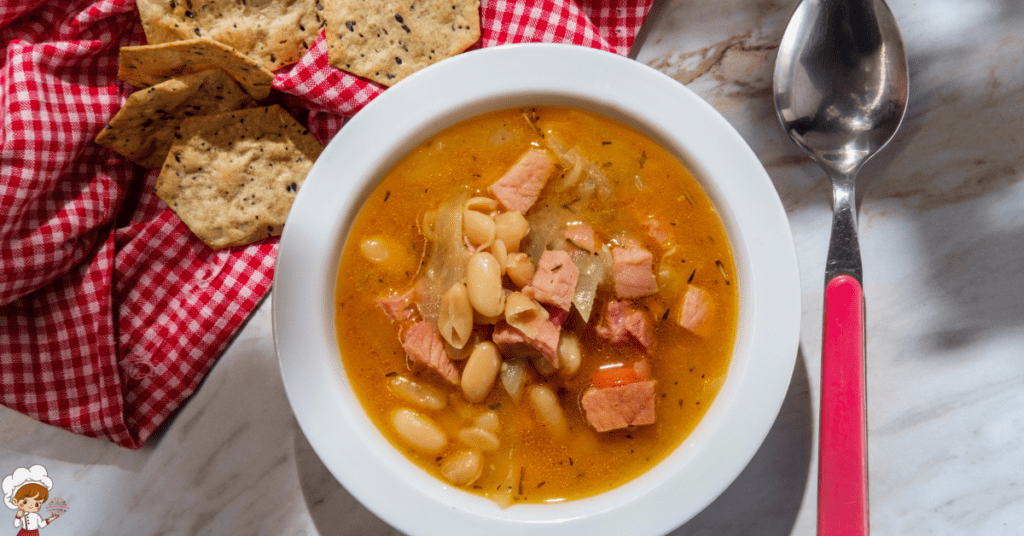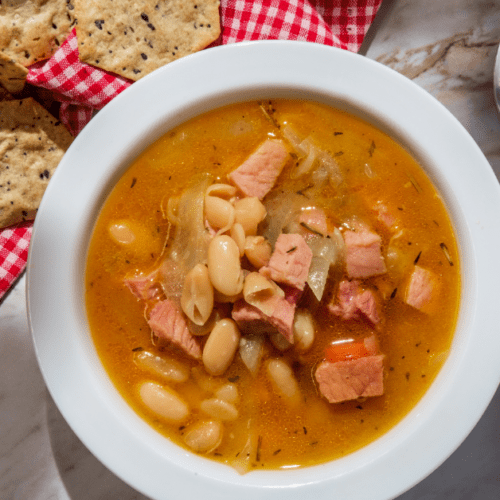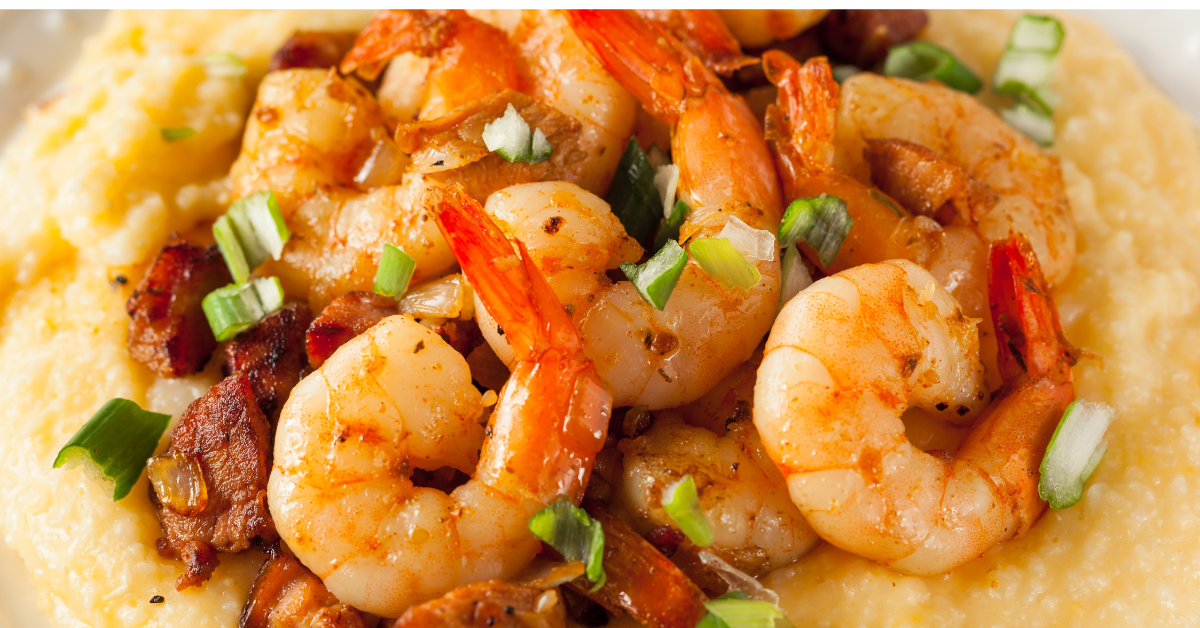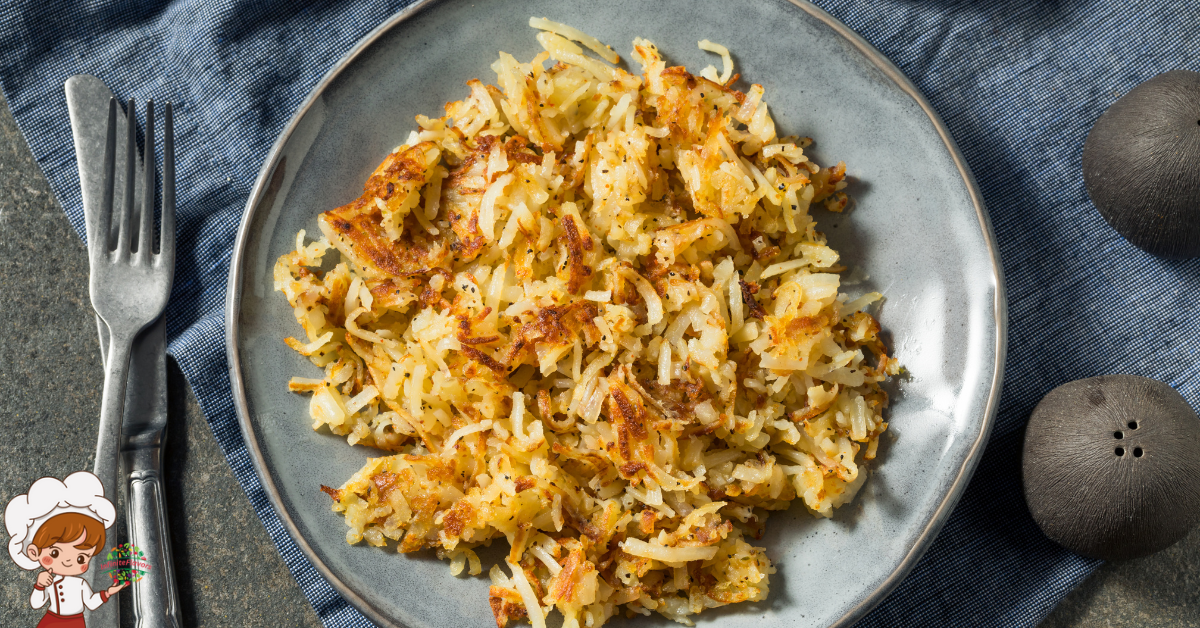Amazing Navy Beans and Ham: A Culinary Tradition with Deep Roots

Amazing Navy Beans and Ham, a classic dish enjoyed by many, carries a rich history that intertwines with cultural, social, and culinary developments across centuries. To truly appreciate this comforting meal, it’s essential to explore its origins, the evolution of its key ingredients, and how it became a staple in American cuisine.
The Humble Navy Bean: Origins and Historical Significance
Origins and Early Cultivation Navy beans, also known as haricot beans or white pea beans, are small, oval-shaped legumes that belong to the common bean family, Phaseolus vulgaris. This species of bean has its roots in the Americas, where it was cultivated by indigenous peoples long before European colonization. The common bean is believed to have originated in Mesoamerica, with archaeological evidence dating its cultivation back to 7,000 years ago in regions that are now Mexico and Peru.
These beans were a staple food for Native American tribes, who developed various ways to cook and preserve them. The beans provided a reliable source of protein, fiber, and essential nutrients, making them a critical part of the diet in pre-Columbian societies.
Introduction to Europe When European explorers, such as Christopher Columbus, encountered the New World, they brought back many previously unknown crops to Europe, including beans. Navy beans quickly gained popularity across the continent due to their versatility, nutritional value, and ease of cultivation. European farmers adopted these beans, integrating them into their agricultural systems and culinary traditions.
Adoption by the U.S. Navy The navy bean’s association with the United States Navy, and hence its name, is a significant chapter in its history. In the early 19th century, the U.S. Navy began including dried beans as a staple in sailors’ diets. This choice was driven by practical considerations: beans were easy to store, non-perishable, and provided essential nutrients that helped prevent scurvy and other deficiencies on long voyages.
By the mid-1800s, navy beans had become a standard ration for American sailors, who would often consume them in the form of bean soup or baked beans. The beans’ hardiness and nutritional value made them ideal for feeding large groups in conditions where fresh food was scarce. This military association is what ultimately gave the bean its popular name: “navy bean.”
The Role of Ham: A Culinary Staple with Deep Cultural Roots
The Origins of Curing Meat The history of ham, particularly its method of preparation through curing, is ancient and widespread. Curing meat—preserving it through salting, smoking, or drying—dates back thousands of years and was a technique developed independently by various cultures around the world.
In Europe, the practice of curing pork, which eventually led to the creation of ham, was particularly prominent. The Celts, who inhabited much of Europe before the rise of the Roman Empire, are credited with developing advanced meat preservation techniques. They passed these methods on to the Romans, who popularized cured ham across their vast empire.
Ham in the American Colonies When European settlers arrived in North America, they brought their culinary traditions with them, including the methods of curing pork. The ability to preserve meat without refrigeration was invaluable, especially in the harsh and resource-scarce environments faced by early colonists. Pigs were among the first domesticated animals brought to the New World by Spanish explorers, and they quickly adapted to the American environment.
In colonial America, pork was a primary source of meat, and the process of curing hams became a vital skill. Ham was an essential component of the settlers’ diet, providing a reliable source of protein during the long winters when fresh meat was unavailable. The tradition of curing and smoking hams was passed down through generations, becoming a deeply rooted practice in American culinary culture.
The Fusion of Navy Beans and Ham: A Dish Born of Necessity and Tradition
The Birth of a Classic Dish The combination of navy beans and ham likely originated out of necessity and resourcefulness. In early American households, especially in rural areas, families had to make the most of what was available to them. Navy beans, being cheap and non-perishable, were a pantry staple. Ham, particularly the leftovers from a cured ham, provided a flavorful and protein-rich addition to meals.
One of the most popular ways to use these ingredients was to create a hearty soup or stew. By slow-cooking navy beans with ham hocks or bone-in ham, early American cooks could extract maximum flavor and nutrition from these simple ingredients. The result was a rich, satisfying dish that was both economical and nourishing.
Regional Variations As with many traditional dishes, navy beans and ham developed regional variations across the United States. In the South, where pork and beans were dietary staples, the dish often included additional ingredients such as onions, garlic, and spices like bay leaves or thyme. The Southern version of this dish might also be more heavily seasoned, reflecting the region’s penchant for bold flavors.
In New England, where baked beans were already a beloved dish, navy beans and ham soup became a popular comfort food, particularly during the harsh winters. The New England version of this dish often featured a milder flavor profile, with a focus on the natural sweetness of the beans and the savory depth of the ham.
Navy Bean Soup: A National Favorite Navy bean soup, a variation of the classic navy beans and ham dish, eventually gained national recognition, particularly through its association with the U.S. Senate. The tradition of serving navy bean soup in the Senate dining room dates back to the early 20th century, though the exact origins are somewhat disputed. One popular story suggests that Senator Fred Thomas Dubois of Idaho requested the dish be served daily, and the tradition stuck. Another version attributes the introduction of the soup to Senator Knute Nelson of Minnesota.
Regardless of its origin, navy bean soup became a fixture on the Senate’s menu, where it remains to this day. The recipe used in the Senate is a simple yet flavorful rendition, typically consisting of navy beans, ham hocks, onion, and water, with salt and pepper for seasoning. This institutional endorsement helped solidify the dish’s place in American culinary tradition.
The Nutritional and Cultural Significance of Navy Beans and Ham
A Nutritional Powerhouse Navy beans and ham, as a combination, offer a balanced and nutrient-rich meal. Navy beans are an excellent source of plant-based protein, dietary fiber, and essential vitamins and minerals such as folate, iron, and magnesium. They are also low in fat and have a low glycemic index, making them a heart-healthy food choice.
Ham, while higher in fat and sodium, provides high-quality animal protein and essential nutrients like iron, zinc, and B vitamins. When used in moderation, particularly in the form of lean cuts, ham can complement the nutritional profile of navy beans, making the dish both satisfying and nourishing.
The combination of these two ingredients offers a complete protein source, as the amino acids in the beans and ham complement each other, providing all the essential amino acids needed by the body. This makes the dish particularly valuable in diets where access to diverse protein sources might be limited.
Cultural Resonance Beyond its nutritional value, the dish of navy beans and ham holds cultural significance in the United States. It represents a connection to the past, particularly to the frugality and resourcefulness of earlier generations. For many, this dish evokes memories of family meals, where simple ingredients were transformed into something special through care and tradition.
Navy beans and ham also reflect the diverse culinary influences that have shaped American cuisine. From Native American agriculture to European curing techniques, the dish is a product of cultural exchange and adaptation. It serves as a reminder of how food can bring people together, transcending time and place to create a shared culinary heritage.
The Modern Revival: Navy Beans and Ham in Contemporary Cuisine
Rediscovering Traditional Foods In recent years, there has been a resurgence of interest in traditional and heritage foods, including dishes like navy beans and ham. As more people seek to connect with their culinary roots and explore the history
of the foods they eat, dishes that once seemed old-fashioned are being rediscovered and celebrated for their simplicity, flavor, and cultural significance.
This revival is part of a broader trend towards slow food and farm-to-table movements, where consumers are increasingly interested in knowing where their food comes from and how it is produced. Navy beans, often grown on small farms in the United States, and artisanal hams cured using traditional methods, align perfectly with these values.
Incorporating Navy Beans and Ham into Modern Diets While the classic preparation of navy beans and ham remains popular, modern chefs and home cooks have found innovative ways to incorporate these ingredients into contemporary dishes. For instance, navy beans can be pureed into a creamy soup with ham for a more refined presentation, or they can be added to salads for a hearty and protein-rich component.
Ham, particularly when sourced from high-quality, pasture-raised pigs, can be used sparingly to add depth and richness to a variety of dishes without overwhelming them. This approach allows the natural flavors of the beans to shine while still benefiting from the umami and savory qualities of the ham.
Some chefs have even deconstructed the traditional dish, using navy beans in creative ways such as bean patties or in pasta dishes, while incorporating ham as a garnish or flavor enhancer. These modern interpretations respect the original dish’s roots while making it accessible and appealing to a new generation of eaters.

Navy Beans and Ham Recipe
Ingredients
- Ingredients:
- 1 pound dried navy beans
- 1 meaty ham hock or 2 cups diced ham
- 1 large onion diced
- 2 cloves garlic minced
- 2 carrots peeled and diced
- 2 celery stalks diced
- 1 bay leaf
- 1 teaspoon dried thyme
- 1 teaspoon smoked paprika optional
- Salt and pepper to taste
- 8 cups water or low-sodium chicken broth
- Fresh parsley for garnish optional
Instructions
- Instructions:
- Step 1: Prepare the Beans
- Rinse and Sort the Beans: Place the dried navy beans in a colander and rinse them thoroughly under cold water. Sort through the beans to remove any debris or damaged beans.
- Soak the Beans (Optional but Recommended): To reduce cooking time and improve texture, soak the beans overnight. Place the rinsed beans in a large bowl, cover with water, and let them soak for 8-12 hours. Drain and rinse the beans before cooking. If you prefer not to soak, you can cook the beans directly, but the cooking time will be longer.
- Step 2: Cook the Beans and Ham
- Sauté the Aromatics: In a large pot or Dutch oven, heat a drizzle of oil over medium heat. Add the diced onion, carrots, and celery. Cook for 5-7 minutes until the vegetables are softened and the onion is translucent. Add the minced garlic and cook for another 1-2 minutes until fragrant.
- Add the Ham Hock: Place the ham hock (or diced ham) in the pot with the sautéed vegetables. Stir in the bay leaf, thyme, and smoked paprika if using.
- Add the Beans and Liquid: Add the soaked and drained navy beans to the pot. Pour in 8 cups of water or chicken broth, enough to cover the beans and ham hock. Stir to combine.
- Simmer the Soup: Bring the mixture to a boil over medium-high heat. Once boiling, reduce the heat to low, cover the pot, and let it simmer gently. Cook for 1.5 to 2 hours, or until the beans are tender and the ham is falling off the bone. Stir occasionally and check the liquid level, adding more water or broth if necessary.
- Step 3: Finish and Serve
- Remove the Ham Hock: Once the beans are tender, carefully remove the ham hock from the pot. If using a ham hock, shred the meat off the bone and discard the bone. Return the shredded ham to the pot.
- Season to Taste: Taste the soup and season with salt and pepper as needed. Remember that ham can be salty, so adjust the seasoning accordingly.
- Serve: Ladle the navy beans and ham into bowls. Garnish with fresh parsley if desired.
- Enjoy: Serve the soup hot with crusty bread or cornbread on the side for a complete meal.
Amazing Navy Beans and Ham: A Dish That Stands the Test of Time
Navy beans and ham is more than just a simple meal; it is a dish with a rich history that spans continents and centuries. From the ancient cultivation of beans by Native Americans to the introduction of cured ham by European settlers, this dish represents a fusion of cultural practices that have been passed down through generations.
Its rise to popularity in the United States, particularly through its association with the Navy and the U.S. Senate, has cemented its place in American culinary tradition. The dish has provided comfort, nourishment, and a sense of continuity for countless people, from sailors on long voyages to families gathered around the dinner table.
Today, as we continue to explore and appreciate the foods of our past, navy beans and ham stand as a testament to the power of simple, wholesome ingredients to create something truly special. Whether enjoyed in its traditional form or reimagined for modern palates, this dish will undoubtedly continue to be a beloved part of our culinary heritage for years to come.








